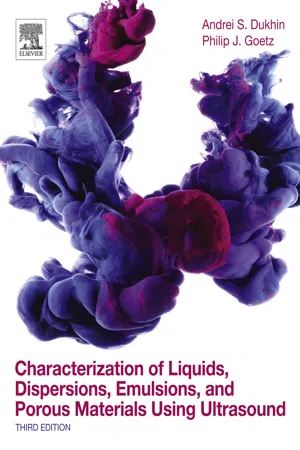
Characterization of Liquids, Dispersions, Emulsions, and Porous Materials Using Ultrasound
- 590 pages
- English
- ePUB (mobile friendly)
- Available on iOS & Android
Characterization of Liquids, Dispersions, Emulsions, and Porous Materials Using Ultrasound
About This Book
Characterization of Liquids, Dispersions, Emulsions and Porous Materials Using Ultrasound, Third Edition, presents a scientific background for novel methods of characterizing homogeneous and heterogeneous liquids (dispersions, emulsions, and gels) as well as porous materials. Homogeneous liquids are characterized in rheological terms, whereas particle-size distribution and zeta potential are parameters of heterogeneous liquids. For porous materials, porosity, pore size, and zeta potential are output characteristics. These methods are based on ultrasound, which opens an opportunity for simplifying the sample preparation by eliminating dilution. This in turn, makes measurements faster, easier, precise, suitable for accurate quality control, PAT, and formulation of complex systems.
This book provides theoretical background of acoustics, rheology, colloid science, electrochemistry, and other relevant scientific fields, describing principles of existing instrumentation and, in particular, commercially available instruments. Finally, the book features an extensive list of existing applications.
- Presents a theoretical multi-disciplinary background of several new ultrasound analytical techniques in one place
- Validates the theoretical basis of several new analytical techniques
- Compares the efficiency and applications of various ultrasound techniques
- Lists many ultrasound applications in colloid chemistry
- Contains an extensive bibliography on this multidisciplinary topic
Frequently asked questions
Information
Introduction
Abstract
Keywords
| Electrical Nature | Electromechanical | Mechanical Nature | |
| Stationary | Condu... |
Table of contents
- Cover image
- Title page
- Table of Contents
- Copyright
- Preface to the Third Edition
- Preface to the Second Edition
- Preface to the First Edition
- Chapter 1. Introduction
- Chapter 2. Fundamentals of Interface and Colloid Science
- Chapter 3. Fundamentals of Acoustics in Homogeneous Liquids: Longitudinal Rheology
- Chapter 4. Acoustic Theory for Particulates
- Chapter 5. Electroacoustic Theory
- Chapter 6. Experimental Verification of the Acoustic and Electroacoustic Theories
- Chapter 7. Acoustic and Electroacoustic Measurement Techniques
- Chapter 8. Applications for Dispersions
- Chapter 9. Applications for Nanodispersions
- Chapter 10. Applications for Emulsions and Other Soft Particles
- Chapter 11. Titrations
- Chapter 12. Applications for Ions and Molecules
- Chapter 13. Applications for Porous Bodies
- Chapter 14. Peculiar Applications of Acoustics and Electroacoustics for Characterizing Complex Liquids
- List of Symbols
- Index